It always amazed me as to how many ways my last name could be misspelled. Some of the best: BENGHOLYS, BENGLUTZ, BERSCHULTZ, BERRYBOLTS.
This play is a reflection on the (im)possibility of accepting diversity and the other. The fragmented body of the neoplasm—the fruit of unstable conditions—overcomes barriers, loves and denies itself and others, wanders around, forgetting its profession. It frequently and with pleasure divides, goes through dangerous palpation, questions the possibility of contact with the experience of the other. Poorly brought up but very successful, it invites us to a trans-species transition.
Lorem ipsum dolor sit amet, consectetur adipiscing elit. Fusce at elit quis felis ullamcorper vehicula non in est. Maecenas finibus pharetra justo et faucibus. Nulla eu tortor vel ex volutpat efficitur. Vivamus placerat turpis in aliquet venenatis. Quisque ac lacinia mauris. Nam quis lobortis elit. Vestibulum sagittis nisi sit amet euismod hendrerit. Mauris non sodales odio. Donec efficitur molestie quam, sed lobortis massa vestibulum ut.
Nunc at arcu sodales nisi porta euismod non vel neque. Phasellus at lobortis ante, in suscipit justo. Proin non purus vitae nisi molestie consectetur. Vestibulum volutpat lobortis interdum. Vestibulum pretium ligula lorem, egestas ultricies lectus ultricies ac. Curabitur venenatis vulputate dolor.
The Archaeology of Philanthropy consists of five sections: “Meeting Life,” “Ashtray, Apple, and Mugs,” “Artistic Life #1,” “Artistic Life #2,” and “Annual Life.”
Artist Statement
Meeting Life: This is a collection of most of the 1,000–plus labels attached to my body at one meeting/event or another, some from Pittsburgh but mainly from my 14 years at the George Gund Foundation. They represent the wonderful opportunities I had to occasionally learn something new, engage in deep reverie sometimes leading to a good thought, renew friendships, and harass enemies. They also represent an incredible investment of time for a relatively small return, suggesting the futility of life. It always amazed me as to how many ways my last name could be misspelled. Some of the best: BENGHOLYS, BENGLUTZ, BERSCHULTZ, BERRYBOLTS.
Ashtray, Apple, and Mugs: This apple and ashtray and a large drawer of paper clips were the only items in my office when I arrived at the Foundation in January 1989. In my obsessive fashion, I was determined to make full use of all the paper clips before I retired. I did. The ashtray and apple, most likely belonging to my predecessor, were of absolutely no use to me. I thought they would be a somewhat feeble welcome to my successor. So I took them with me when I left. They are displayed here for no discernible purpose. Also included are two “Hello My Name Is” mugs presented to me recently by a friend from my Pittsburgh days, Paul Brophy.
Artistic Life #1: One of the artistic components of my work, other than this attempt at conceptual art, is the production of twelve annual reports containing black & white fine art photographic portfolios by noted national and local photographers. This was accomplished in collaboration with the distinguished Cleveland graphic design firm Nesnadny + Schwartz and the Gund Foundation program officer, Deena Epstein. These reports are my passion and my pride. They represent the foundation’s good works and the special geography and ecology of Cleveland. They received more than 100 national and local awards, well deserved from my perspective.
Artistic Life #2: As if compulsion was not deeply rooted enough in my work life, some years before I retired another shoot began to emerge at home. Inexplicably, I began to take Polaroid photos of our garden and indoor plants. Everyday. It became another comforting, satisfying ritual that gave structure to the inner chaos of my days. These images, like my day cards, now number in the thousands. As they piled up, I squirreled them away in shoeboxes. Only recently have I delved into them to mount or frame for presentation.
Annual Life: During the time I spent at the Gund Foundation, my assistant Alice Cardillo and I, in some rickety fashion, were conjoined. She kept trying to keep me on the rails. I was continually falling off. On one spindle is a display of my yearly life from January 16, 1989, to January 15, 2003, as well as the past year of my retirement. On the other is a mostly matching set of calendars kept by the valiant Ms. Cardillo in her attempt to exert some control and order over my comings and goings. I began my work at the Foundation with a pocket calendar, which was the manner in which I ‘organized’ my life in Pittsburgh. The impossibility of keeping my own calendar here became abundantly apparent within the first few months. I was stripped of this much–loved device in March 1989 and presented by Ms. Cardillo with a much larger desk calendar in the hope that my randomness might be checked.
Exhibition
David Bergholz is a photographer and artist who has exhibited his images and conceptual work at SPACES, Heights Arts, Murray Hill Galleries, LLC (NEO+1), The Cleveland Botanical Garden, the John F. Seiberling Gallery in the Cuyahoga Valley National Recreation Area, the Massillon Museum, the Maltz Museum of Jewish Heritage, and the Firelands Association for the Visual Arts in Oberlin. His work is in the collections of the Cleveland Clinic Foundation and University Hospitals as well as several corporate locations.
He was the executive director of the George Gund Foundation in Cleveland from 1989 to 2003. He worked for more than forty years in the non-profit sector in Pittsburgh and Cleveland before his retirement in 2003. Bergholz worked in the areas of community and economic development, education, the arts, health care, city planning and government improvement.






